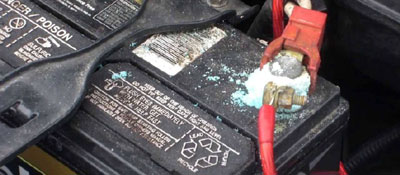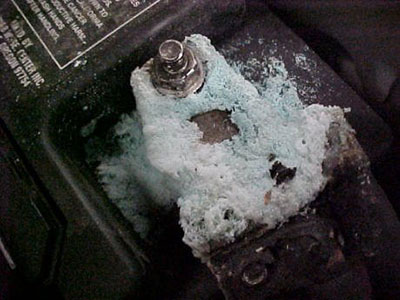How to Clean Car Battery Corrosion Safely
To get rid of battery terminal corrosion, mix baking soda and distilled water, dip a brush in the mixture, and then brush away the blue-green foam carefully.
Even though corrosion is natural and normal for healthy batteries, you should clean your battery terminals every six months. Otherwise, too much buildup of the white, blue or green powdery substance could keep your car from starting. Corrosion can either build up between the post and the terminal or it can wear away the terminal and cables until they're too brittle to stay connected. Too much corrosion can stifle a battery's connection, making the alternator work harder to charge the battery and the battery work harder to start the engine.
Cleaning your battery terminals free of corrosion keeps that connection strong. You can also spray a corrosion preventative to keep your battery terminals clean much longer. While corrosion isn't directly caused by battery acid, you still do not want to touch it.
How to Clean Battery Corrosion in a Few Simple Steps
- Safety first. Wear safety glasses and gloves. Make sure you have good airflow around the battery compartment.
- Hook up backup power. Before cleaning the corroded battery terminals, connect a memory saver.
- Disconnect the car battery. Cover the positive terminal and pull the battery cable away from the battery to make sure the terminal and battery post don't touch while you're cleaning.
- Prepare the neutralizer. Mix the baking soda and water, either in a cup or on the brush. Don't do this on the battery case itself.
- Apply the mixture slowly at first. Use the brush first to sweep corrosion off the top of the battery. To neutralize the corrosion, work the baking soda into any big chunks of corrosion you find.
- Brush away from vent caps. Avoid getting your mixture into raised vent caps or holes at the top of the battery.
- Scrub the metal. Use the wire brush on the battery posts and metal terminals, even if you can't see corrosion on them.
- Neutralize anything left. Apply extra water and baking soda as needed to neutralize the corrosion around the battery casing. Wipe away with a paper towel.
- Dry the top thoroughly. Wipe down the terminals and top of the battery case. Again, make sure none of the baking soda-water mixture goes inside the battery case.
- Reconnect the battery. Connect the red positive terminal first, then attach the ground.
Battery terminal corrosion could be a sign of something more!
Car battery terminal corrosion might be a sign of a bigger issue. Get a battery test at your nearest Interstate All Battery Center or any location where Interstate is sold.
You can clean battery terminals while they're connected, but you might not get to the corrosion buildup between the battery post and the terminal. That's the spot you most want to remove corrosion from. If too much corrosion builds up there, it can keep your car from starting.
Battery Corrosion Cleaning Supplies
With these supplies, you'll be well equipped to clean corrosion from a car battery.
- Baking soda and hot water. Warm water mixed with baking soda will neutralize the corrosion so you can safely brush it away.
- A wire brush. Use a safety brush when cleaning the lead battery posts and the car's clamps.
- A plastic brush. Nylon brushes for cleaning dishes would work well, but you could use a toothbrush, too. (Just throw it away afterward.)
- A towel or rag. You will need to dry the battery and terminals after clearing the corrosion.
- Gloves and eye protection. Plain sunglasses could work if you don't have any protective eyewear.
- A well-ventilated space. Do it outside, in the open garage or with a fan blowing away from you.
- A memory saver for cars. If you're cleaning a car battery and its clamps, you'll need to disconnect it. Disconnecting without a memory saver can cause expensive electrical problems. (A memory saver will prevent issues with your electronics, and it's available online for $9 to $20.)
Baking Soda Cleaning Solution Recipe for Cleaning Battery Terminals
Ingredients:
- 4 tbsp baking soda
- ¼ cup warm, clean water or a mild acid such as white vinegar or lemon juice
- Put on safety wear to keep any particles from getting into your eyes or skin.
- Mix the baking soda paste thoroughly until you get a toothpaste-like texture.
- Scoop the mix onto a wire brush.
- Slowly brush corrosion away from you.
Better Than Baking Soda: More Professional Products for Cleaning Battery Corrosion
Battery Corrosion Cleaner. Shake it up and spray it on corrosion. After a few minutes, you can brush it away. Shake it up and spray it on corrosion. After a few minutes, you can brush it away.
Corrosion Preventative. Spray this after cleaning corroded terminals to prevent new corrosion from forming quickly.
Dielectric Grease. Cake it on after you reconnect the battery and it'll seal out anything that would interrupt the flow of electricity. It doesn't conduct electricity, so don't put it between the post and the clamp. If your clamps have any exposed wiring, a layer of this can prevent corrosion from creeping up the wire under the rubber.
Battery Post Brush. Imagine a thimble the size of a battery post, except with dozens of metal bristles inside. While handy and does the job in a pinch, it's not especially necessary if you only clean your car battery once or twice a year.
WD-40. You can use WD-40 on battery posts because it works its way into corners to neutralize corrosion, but it's not ideal. You can use a special WD-40 contact cleaner designed for sensitive electronics. WD-40 can turn into tomorrow's grime if you leave it in there today.
Go to our pros to clean battery corrosion.
Want to clean your car battery without all the fuss? Take it to the pros at an Interstate All Battery Center or one of the trusted repair shops that sells Interstate Batteries.
Don't Use Coke to Clean Your Car Batteries. Here's Why.
Cleaning a car battery with Coke might seem like an easy solution, but it's just as likely to bring in new problems. Pouring Coca-Cola on a car battery to clean corrosion can also bring in new problems because Coke can leave a brown, gummy residue in the battery compartment and other car parts. That residue on sensitive wiring, a timing belt, etc., can interfere with high-performance car parts. Also, if any amount of Coke gets into the car battery, that tasty drink can interrupt the sensitive chemistry inside. The only liquid you can safely add to a car battery is distilled water.
Even the Coca-Cola company agrees, the soda is better for drinking than for cleaning car batteries. If price is an issue, get some baking soda and water. If Coke seems easier, remind yourself that trying to diagnose new problems after pouring Coke in your engine compartment could be much harder.

What Causes Car Battery Corrosion?
You might think battery acid itself is the culprit, but that's only part of the story. Battery acid can cause corrosion if the battery has a cracked case. However, there's another cause that's far more common: Hydrogen gas. Here's how it works.
Battery fluid is a mix of sulfuric acid and water, and it looks like clear water. Any color in the mixture of sulfuric acid and water comes from a chemical reaction to trace elements in the water. When you clean the terminals with baking soda, you might spot battery acid if the corrosion or a liquid turns into a foam, then that may be battery acid coming through a crack in the case. Otherwise, the corrosion may flatten into a thin liquid.
When you start the car or the alternator recharges the battery, the liquid inside the battery changes acidity:
- Charging a battery makes the liquid more acidic.
- Using a battery makes the liquid mostly water.
Something else happens, too: electrolysis. Electricity can split water molecules into oxygen and hydrogen. Most of the time, the battery case keeps these gases inside until they reabsorb into the battery acid. If there's too much pressure built up in the case, a safety valve will release tiny amounts of hydrogen.
Hydrogen gas is odorless, colorless and nontoxic to people. It is corrosive to metal. Remember hydrogen from the top of the periodic table? With just one proton and one electron, hydrogen reacts easily to lead, copper, steel, etc. If there's not much airflow around the car battery, that gas can linger and can gradually corrode most metals.
In fact, the color of corrosion comes from the kind of metal reacting to the hydrogen:
- Green or blue corrosion comes from hydrogen gas corroding copper, usually the wiring or clamps.
- White corrosion comes from corroded lead, zinc or aluminum.
- Brown or red corrosion comes from corroded iron or steel, which is notably less common but can happen.

The color of corrosion doesn't say much about the performance of the car battery or your car's charging system. Instead, the presence of corrosion itself is a sign that your battery drained and recharged a significant amount of power recently.
Corrosion at the negative terminal? It might be the starter.
Corrosion around your negative cable could hint at a problem with the starter. Visit your nearest Interstate All Battery Center or any location where Interstate is sold for a thorough test of your car battery starter and charging system.
You may have taken a long drive with a mostly drained battery, so the recharging and high temps under the hood led to more hydrogen release than usual. You might have a power-hungry aftermarket accessory with extra parasitic drain, and the charging system worked hard to refill the power. The weather may simply be very hot, with natural evaporation and condensation happening in the battery case, when a little recharging adds just enough pressure to release some hydrogen.
In short, corrosion means the battery has been recharging in high temperatures.

Does Corrosion Mean a Car Battery Is Bad?
No, corrosion itself does not mean a car battery is bad. It just means you need to take a closer look.
Corrosion is a sign that your car battery was recharging while hot and potentially in a poorly ventilated area, like a tight space under a car hood. However, if the battery needed to be recharged, it was drained. Also, draining a battery for too long can damage a car battery, right?
Corrosion is a good example of correlation but does not mean causation.
Often, you can clean corrosion off a battery and expect it to last five years or longer. Corrosion, if thick enough, can keep your car from starting and keep the battery from getting recharged. Corrosion alone does not mean a battery has gone bad. It may be a sign that your alternator is overcharging the battery, or there may be a small enough crack in the battery case near a terminal to let a few drops of battery acid corrode the posts. You may find some corrosion that was caused by charging in high temperatures a year ago, and the battery's just fine today.
The only way to know if your battery is weak is with an actual battery test.
RELATED: See these subtle signs of a dead battery.
Is It Safe to Touch Car Battery Corrosion?
No, please don't touch battery corrosion. Whether there's trace amounts of battery acid or merely corroded metal, the ashy, powdery corrosion on the terminals will irritate your skin. That's why we always recommend you equip protective gear of some kind before handling batteries.
Nitrile gloves can protect your hands, and any kind of eyeglasses can protect your eyes. On top of that, staying in a well-ventilated area keeps you from inhaling stray particles of corroded metal.
If you do accidentally touch corrosion, run water on your skin for 30 minutes and use baking soda to neutralize any caustic substances that might be on your skin.
Let the pros protect your battery from corrosion.
Visit your nearest Interstate All Battery Center or any location where Interstate is sold to test your battery.




